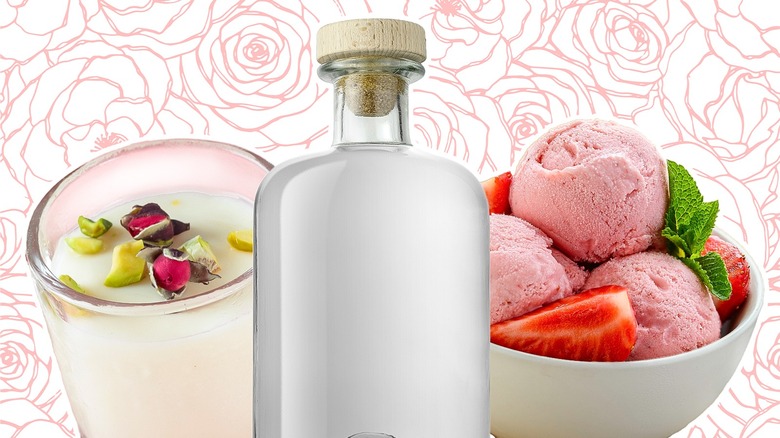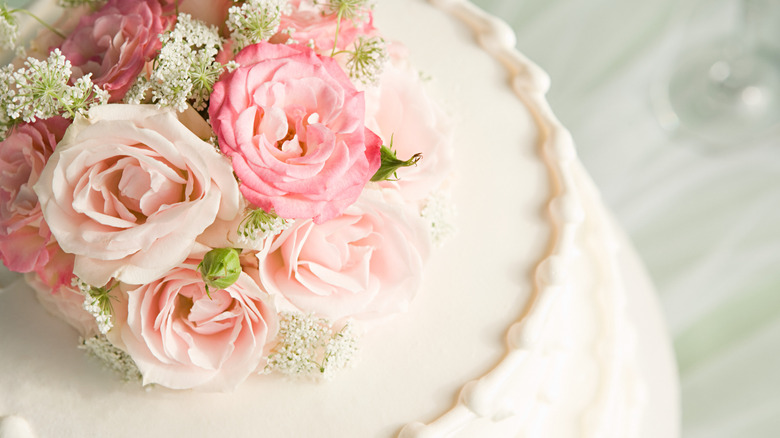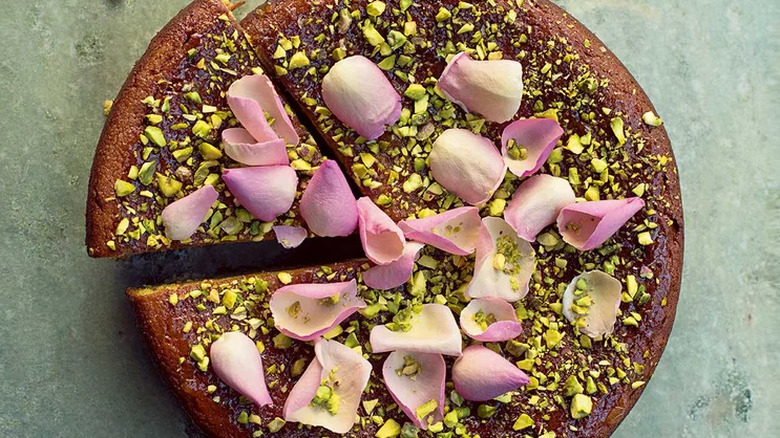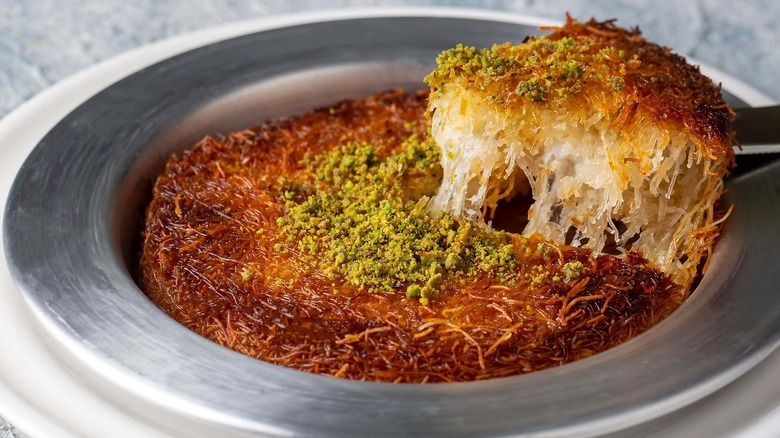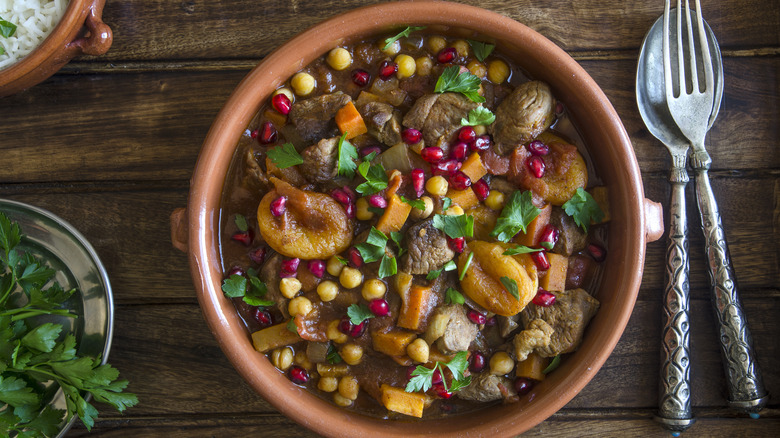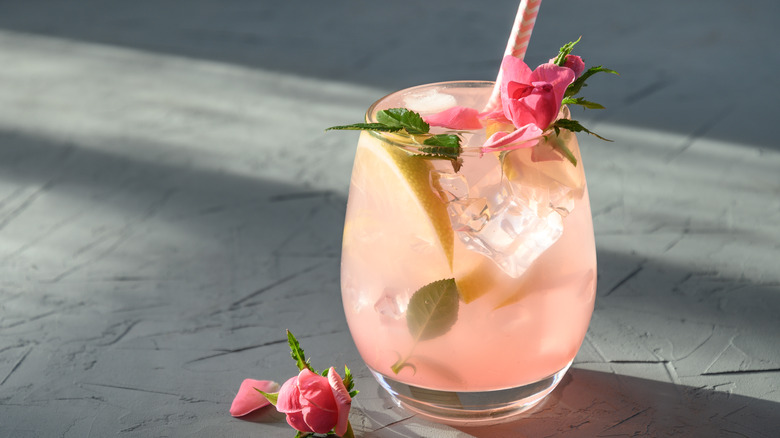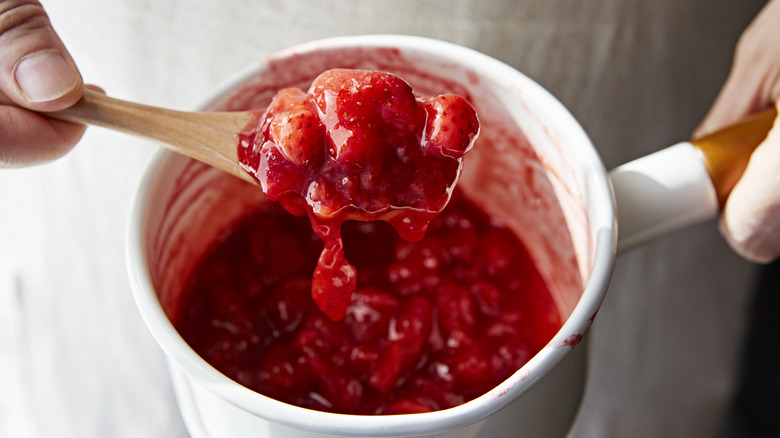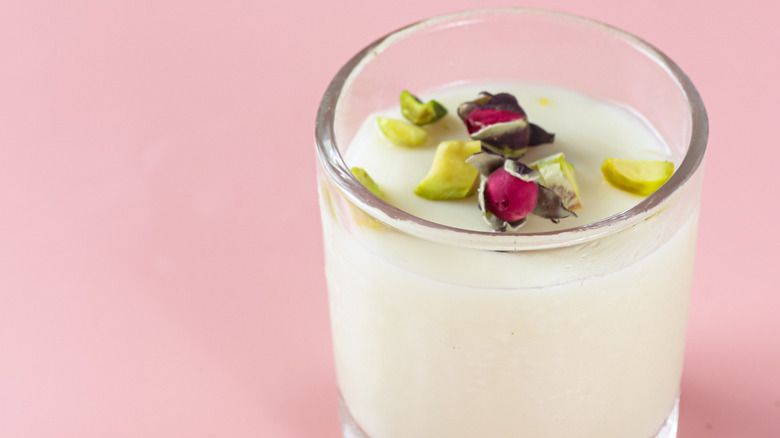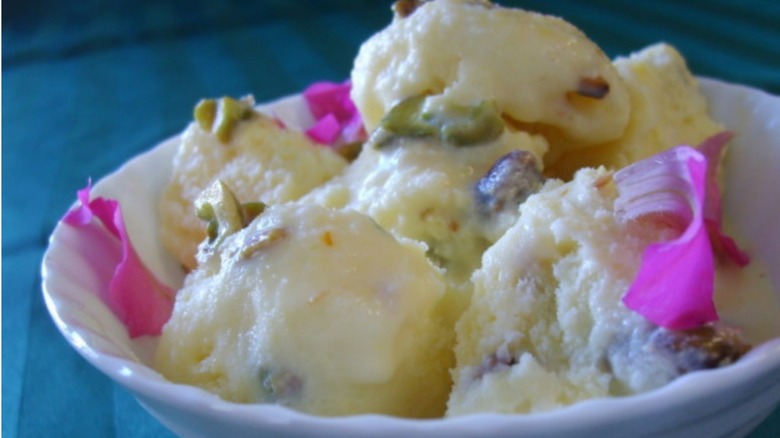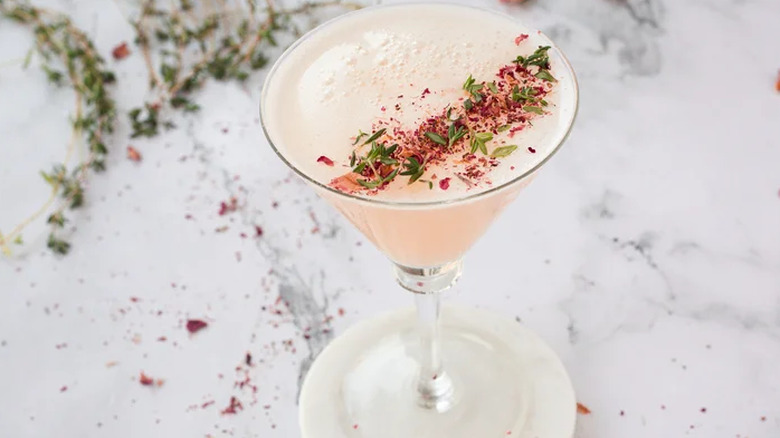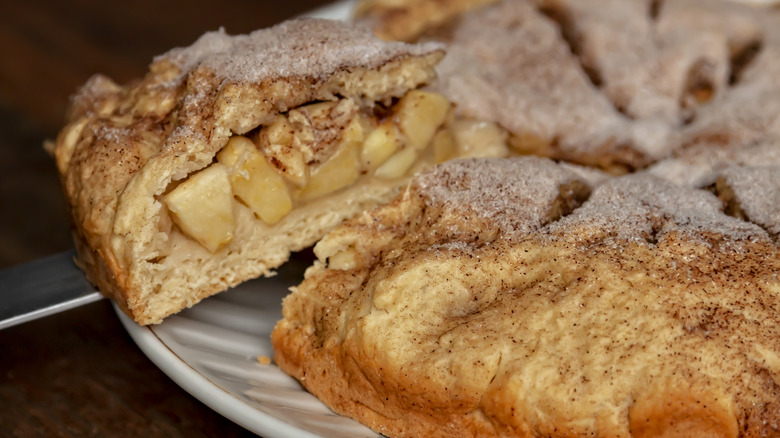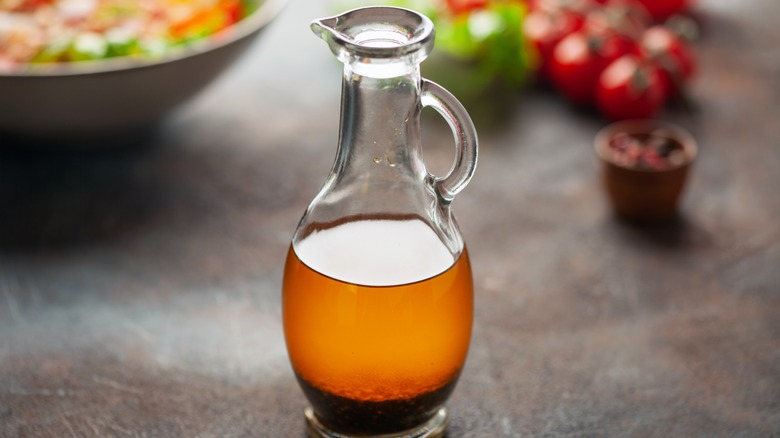12 Easy Ways To Use Rose Water
If you love the aroma and taste of roses, rose water is a wonderful thing to keep in your pantry to elevate your cooking, drinks, and baking. You may be familiar with it because of how popular it is in Middle Eastern and South Asian cuisine, but if you don't know about this beautifully floral ingredient, rose water may sound a little intimidating to use. Furthermore, you might be thinking that roses are meant to be smelled and not eaten.
As someone with Egyptian heritage, rose water is an ingredient I'm intimately familiar with, and I like to use it in both traditional and non-traditional ways. I grew up with rose water-spiked desserts and drinks, and I've carried it into my adult life as a recipe developer, playing around with it in all sorts of ways.
It has a distinct rose flavor, and once you taste it, you'll get what makes it so popular in different parts of the world. Rose water allows you to easily infuse anything with a mild rose flavor, as its liquid state means you can simply add a couple of drops to whatever you're making. It's always best to use just a little because when too much is added, your dish might taste soapy, so less is always more. If you don't know where to start, here are some easy ways to use rose water.
1. Add it into your cake mix
In Middle Eastern cooking, rose water is the central flavor behind all kinds of sweets and baked goods, and it's as essential as vanilla is to Western desserts. Vanilla is so commonplace in baking that we actually associate the vanilla flavor with neutrality. That same logic tends to apply to rose water in desserts from North Africa and the Middle East, where the taste of rose is akin to a neutral dessert flavor and can even be used in baked cake instead of vanilla. The nifty thing is that rose and vanilla go so well together that there's no reason to choose one or the other, especially when baking cake. Add them both, and they'll support each other's flavor, making an extra tasty result.
With cake, it's just as easy to add a teaspoon or two of rose water into your cake batter as it is vanilla, and it's usually best to add them at the same time. The only thing is that rose water can lose some of its potency when heated, so you may not taste it as much after the cake has been baked. One way to avoid this is to add a little more than usual. However, rose water is known for being overpowering if you add too much, so there's a fine balance. In my experience, adding two teaspoons to a medium-sized cake is enough to add a subtle but delightful floral aroma.
2. Make a floral cake frosting or glaze
If you want to make a rose-scented cake, you don't have to stop at the cake batter. To reinforce the rose flavor, you can also add a few drops to your cake frosting. In fact, this is a really effective way to incorporate rose water as it won't be cooked off in the baking process. Additionally, you can always taste it to see if you need to add a little more — remember, less is more with rose water. Rose water can be mixed into any type of frosting, whether you're making butter icing, whipped cream frosting, buttercream, or cream cheese frosting. You use so little of it that it won't alter the texture in any way. Simply add it in before or during mixing/whipping the frosting.
If you're not using frosting, you can also include rose water in a cake glaze. Add a teaspoon to your glaze before brushing it on your cake. You can take inspiration from this pistachio, pear, and rose cake recipe by Nigella Lawson, where you mix some rose water into the glaze mix, which is made from lemon juice and apricot preserve.
3. Use a rose water simple syrup for desserts like knafeh
One of the more traditional ways rose water is used is by adding a couple of drops into a simple syrup made of sugar and water. Syrup is key to many Middle Eastern desserts like knafeh, baklawa/baklava, or basbousa. If you've ever tried these, you'll know just how important the syrup is. It's the secret behind the sweetness of these desserts that don't always have sugar in them other than the syrup. When the sweets are doused in a light syrup, they get a glossy finish and sometimes an intensely sweet taste. While it's not always the case that rose water is in these desserts, many people add a little to give it a bit more complexity. Sometimes rose water and orange blossom water are used in conjunction, resulting in an explosion of floral notes.
If you're trying your hand at making these desserts, mastering the syrup is essential. While the desserts look intricate, many of them are quite easy to make, and the syrup is one of the easiest parts. There are no hard rules about the ratio of water to sugar, as this depends on how thick you want your syrup — more sugar to water means thicker syrup. It's always a good idea to start with a one-to-one ratio, using one cup of sugar to one cup of water. Place the pan on medium heat and stir until the sugar has dissolved. As the syrup begins to bubble, you can turn down the heat. Your syrup is ready to use, and all you need to do is drop in a teaspoon of rose water to get that lovely rose flavor.
4. Drop some into lamb stew
Rose water doesn't contain sugar and is not sweet on its own — if your rose water is sweetened, you've purchased a rose syrup. Being unsweetened makes it suitable to use in various ways beyond just sweet dishes and drinks. In fact, the flavor of rose goes really well with many savory dishes.
Rose water is sometimes used in biryanis, and dried roses are often added to spice blends like ras el hanout or spicy pastes like harissa, which illustrate how the flavor of rose can seamlessly mix into savory foods. Meat and flowers don't sound like they would go together, but rose water adds a pleasant and interesting element to meat dishes. In my experience, I've found that in certain Turkish or Persian/Iranian dishes, it's not uncommon to add rose water and even rose petals to lamb. It's subtle but adds an incredible aroma that balances out the meatiness of the lamb.
To make a cohesive lamb dish with rose water, it's a good idea to use other aromatics that would complement it. Take inspiration from a dish like gormeh sabzi for example, and incorporate herbs and spices like fenugreek, parsley, turmeric, and saffron. Always add the rose water at the end of cooking, or its flavor might get cooked off. Mix it into your lamb stew when you turn off the heat and serve. Always start with one teaspoon or less, and then taste to see if it comes through.
5. Splash some into your favorite iced drinks
Rose water may be great for cooking and baking, but it's also a really useful ingredient for drinks of all kinds. A little rose water will brighten up an iced drink like lemonade excellently, taking it up a notch and giving it a bit of a botanic edge. In several North African countries, you'll find fruit juices like orange juice spiked with a hint of rose water, making regular juice taste special. It's one of the easiest ways to spruce up an ordinary beverage. Plus, the flavor of rose water suits many types of juices and cold drinks surprisingly well.
A really great way to use rose water is to make some rose iced hibiscus tea. The ruby color of the hibiscus beautifully signals florals, while the tart hibiscus flower is mellowed out by the rose flavor. You could also make paneer soda, a drink that's often served at Indian weddings. Recreating this refreshing drink at home couldn't be easier. You need to mix soda water, simple syrup (or sugar), and rose water, and you've likely found your new favorite summer beverage.
6. Add it to your homemade jam or compote
One of life's simple pleasures is a jar of homemade jam or fruit compote. You get to use your favorite fruits, control the amount of fruit and sugar you use, and flavor it just the way you like. This is where rose water comes in, as it's one of the ways you can give your homemade jam nuance. Rose water goes really well with all types of fruit, and it can add a lovely sweet balance to tart fruits like strawberries, cranberries, and sour cherries, or citrus fruits. All you do is mix in a couple of drops of rose water to the jam at the end of cooking before you fill up your jar. A little goes a long way, especially with jam, and you'll really want to be careful not to add too much as it can easily overpower the delicate fruit flavors.
Rose water also goes great with milder-tasting fruits like apples and pears, and it's a great way to spruce up a simple compote. You can still use any warming spices you like using these fruits, like cinnamon, ginger, and cloves, and drizzle in a couple of drops of rose water to give it some pizzazz.
7. Try mahalabiya or milk pudding
Something about the delicateness of rose water makes it incredibly well-suited to creamy desserts. This is probably best illustrated in mahalabiya, a Middle Eastern milk pudding that likely inspired many classic desserts, like Spain's manjar blanco and Italy's panna cotta. This creamy delight is made with a few simple ingredients like milk, sugar, and cornstarch, but the addition of rose water gives it an added layer of dimension. The rose water lightly perfumes the milk, balancing out the richness and making the dish incredibly moreish.
Mahalabiya is perhaps one of the best ways to highlight the flavor of rose water, as the distinct taste is not meddled with by any other ingredient. Using a similar concept, you can add rose water to other creamy desserts. Whether you're making rice pudding, a simple vanilla pudding, panna cotta, or even custard, you can add a splash of rose water to give it that extra oomph.
8. Make rose water ice cream
As rose water is known for complementing creamy desserts, rose water ice cream is a no-brainer. Whether you're making a no-churn ice cream or you have an ice cream maker at home, you should try adding rose water to your next batch for a truly delicious and delicate flavor. With rose water ice cream, you don't need much fanfare — just add a teaspoon or two of rose water to a simple sweet cream, and you'll be delighted by the result. For more allure, you can top it with chopped pistachios and dried rose petals.
If you love making more intricate flavors of ice cream, rose water pairs really well with all types of fruit, especially ones that will produce a pink color to give a nod to pink roses. Strawberry is one option. To really take things to the next level, you should try cardamom, rose water, and coffee ice cream to make a sophisticated ice cream flavor that mimics a spiced Turkish coffee that will knock your socks off.
9. Mix it into your cocktails
Since rose water works so well with drinks, it's an obvious ingredient to elevate a cocktail. It pairs excellently with different types of liquor and would just as easily spruce up a gin fizz as it would a wine cooler. If you love a frozen drink, add a splash of rose water to a strawberry daiquiri or a frozen rosé cocktail. Otherwise, keep it classy with a rose water lemon drop, topped with some edible rose petals for added elegance. The key is to choose light fruity, sweet, or sour flavors that the subtle floral notes would work well with. This means you'd best stay away from whiskey or bourbon, for example, which could overpower the rose water.
If this all sounds a bit intimidating, it's really nothing more than adding a couple of drops of rose water to your drink and making it as you usually would. A really easy way to incorporate rose water into a cocktail is by adding half a teaspoon to a glass of gin and tonic. To try something a lot more lavish, this spring blush negroni recipe involves shaking up some gin, Lillet Blanc, Suze, egg white, and foaming bitters with ½ teaspoon rose water. Shake first without any ice for about 15 seconds so that the egg white emulsifies, and then shake with ice until your drink is chilled. Pour it into a martini glass and garnish with some crushed rose petals and fresh thyme leaves.
10. Brighten up your apple pie filling
There's little as comforting as a warm apple pie, especially around the beginning of fall. While eating apple pie is obviously the best part of making it, a close second is the smell. When the aromas of apple, cinnamon, and nutmeg fill your home, everything feels cozier and more magical. Bringing rose water to this mix makes everything even more delicious. While nothing beats the classic flavors, adding a hint of floral goodness to your apple pie filling won't detract from anything and will make it even more aromatic. As little as a teaspoon of rose water in your apple mixture does wonders to brighten the dish.
Remember to add the rose water to the apple filling at the end of cooking. It will still cook further once you assemble your pie, so make sure you can prominently taste the rose in your filling before you bake your pie (since you'll lose some of the fragrance during cooking). You also don't have to stop at apple pie. Rose water goes great with lemon pie, cherry pie, or any type of berry, too.
11. Shake it into a vinaigrette
Salads can sometimes be considered the less interesting dish in your meal, but they don't need to be, especially if you make a zingy, delicious dressing or vinaigrette. A vinaigrette can really make a salad as it's the flavor that will coat all the veggies, so it's where you want to put all your effort to make it taste great. While mustard, balsamic vinegar, and shallots are classic vinaigrette ingredients, you should consider throwing rose water in the mix. It won't make your salad sweet but will add a little more aroma and intricacy to it, especially if you incorporate some sourness like lemon juice or other citrus to the mix, which complements the flavor of rose.
In my experience, rose water works best with a vinaigrette made of olive oil, white vinegar, salt, pepper, and a sprinkle of sumac. The tartness of the sumac is mellowed out by the rose water while adding a beautiful rose-colored hue to the dressing. This is the perfect vinaigrette for a fresh green salad with some radishes and cherry tomatoes, or even on a more decadent pear and gorgonzola salad.
12. Spray rose water on your face
Aside from cooking and baking, rose water is actually often used for skin care. It has been used for centuries in the Middle East as a natural remedy for various ailments. In my childhood, I was taught by aunts and the older generation to spray rose water on my face to freshen up, and it's often used as a natural skin toner all over the Middle East. This is something that's still part of my skincare regimen to this day, and it's something I've heard people from various parts of North Africa and the Levant still do.
Rose water is known to soothe skin, reduce irritation, and has antiseptic properties, which can help heal scars and cuts. Keep in mind that there is cosmetic rose water that's not edible and is used entirely for skin care. You shouldn't use this kind in food, but it's fine to use edible rose water on your skin. You should be able to find rose water in larger grocery stores; visit your local Middle Eastern or Indian grocery to get good quality rose water or some variety. If you're concerned about not being able to tell which is food-grade rose water, don't worry, it will always be found on the shelf next to other food products.
